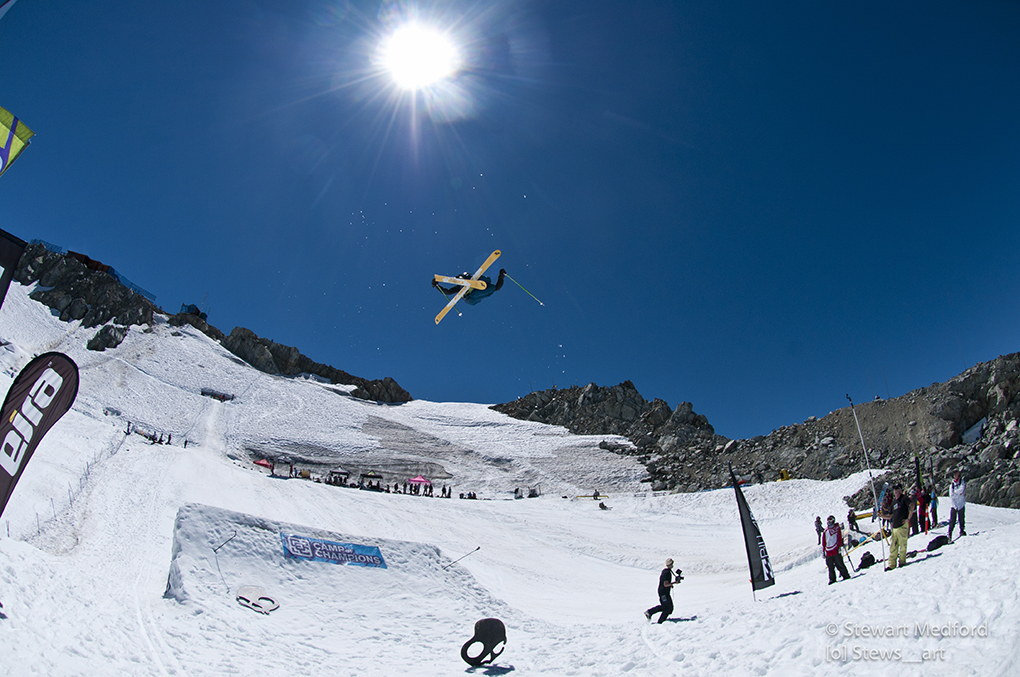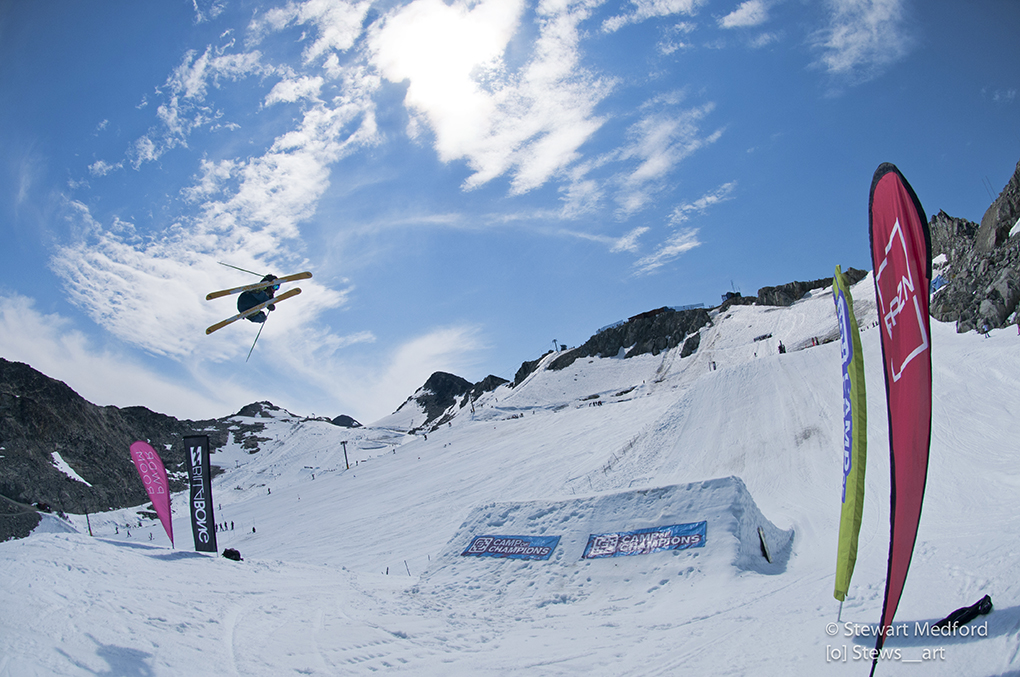
Ski: 2015-2016 Nordica OMW, 181cm
Dimensions (mm): 121-89-113
Sidecut Radius: 22 meters
Mount Location: -1cm from true center
Boots / Bindings: Dalbello Il Moro Comp I.D. / Rossignol FKS 140
Days Tested: 9
Test Locations: Crested Butte and Keystone, Colorado; Whister Blackcomb Resort and Camp of Champions, British Columbia
MSRP: $499
[Editor’s Note: Our review was conducted on the 14/15 OMW, which was not changed for 15/16, except for the graphics.]
In the past few years, Nordica has made a serious push to revitalize the freeskiing side of the brand from both a marketing and product perspective. Where the Ace of Spades line was once the centerpiece of Nordica Freeskiing, the OMW and the Soul Rider have been pushed to the fore by a younger, more stylistically-inclined team of athletes that make up the core of Nordica’s revamped image.
The OMW, which stands for “One Man Wolfpack,” is billed as something of a one-park-ski quiver that can handle all types of park features. There are currently a number of high quality skis on the market that aim for versatility—the Armada AR7 and Atomic Punx immediately come to mind—and given that most park skiers probably aren’t hyper-focused on just one specific aspect of park skiing, this is a good thing.
To be expected from a “versatile” park ski, the OMW has a medium to slightly stiff flex that is consistent throughout the ski, with the flex softening only slightly toward the tip and tail. It also has a slightly directional sidecut, which I will say more about in the next section.
Finally, Nordica only produced the OMW up to a 177cm length for the 13/14 season (the first production year of the ski). For the 14/15 season, the OMW is 3mm wider underfoot, has a slightly longer turn radius in all lengths, and is now available in a 181cm length.
Jumps
I just got back from Whistler’s Camp of Champions, where I was able to get seven good days hitting a variety of jumps in a range of different conditions on the OMW.

I found that the OMW performs as advertised: not quite up to the standards of a stiffer, competition-ready slopestyle ski, but well enough to get the job done without significant drawbacks that would make the ski noticeably less enjoyable.
First, the shape of the OMW: non-symmetrical, 89mm-underfoot, not too wide in the shovel but wide enough to give it some shape – is the distillation of most successful shapes that perform well on park jumps. The OMW is wide enough that it acts as a solid, stable platform underfoot, but isn’t so wide in the shovel or underfoot to give the ski a cumbersome swing weight.
The asymmetry of the OMW allows for very predictable carving into and out of jumps when performing forward takeoff tricks, but isn’t so dramatic that it becomes a drawback when taking off switch.
Park Skis: Symmetrical vs. Non-Symmetrical Designs
Many people (myself included) believed for a while that symmetry was a vital property of any good park ski, but I’m becoming less inclined to view it as a requirement for skis to perform well on jumps. Because skis don’t turn all that similarly when going backward as they do when going forward, since one’s stance and body position are entirely different skiing forward versus skiing switch.
So it’s now less important to me that a ski has a symmetrical shape, and more important that a ski carves really well when skiing forward, for two reasons: First, symmetrical skis don’t carve all that predictably or easily when going forward, and second, nuances in the ski’s performance are less noticeable when riding switch into a jump. When performing switch tricks, carving one’s takeoff leaves very little margin for error in terms of good takeoff timing (among other difficulties), and as a result, most people opt to take off flat-based when hitting jumps switch.
Stability (with comparisons to the Armada AR7 and the Fischer Nightstick)
The OMW is quite stable—not best in its class, but it more than gets the job done for a multi-purpose park tool. Its medium-stiff flex doesn’t give out when landing heavily on either the tips or tails, whereas a softer ski might over flex and cause the rider wash out more frequently.
Also, its 89mm-width aids in stability underfoot by providing a solid lateral foundation without waist width becoming a burden. For reference, the similarly-billed Armada AR7 (87mm-underfoot in the 181cm length) is comparable to the OMW in terms of stability, and a more competition-specific park ski like the Fischer Nightstick (84mm underfoot but considerably stiffer than the OMW or AR7) is noticeably more stable. But the OMW is infinitely more playful than the Nightstick, and comparably playful to the AR7, another ski that is an absolute blast to ski in the park.
In short, the OMW is stable enough to hold its own on jumps day in and day out without sacrificing playfulness.

Jibs
On other types of park features, the OMW behaved exactly as I expected and hoped it would. The ski’s relatively low swing weight allowed for more agile rail tricks like switch ups and spins onto rails without hindrance from the ski itself, but to a less effective degree than say the Scott Jib TW. Speaking of switch ups, the OMW’s camber is fairly mellow and didn’t become an obstacle when performing surface switch ups, as the Fischer Nightstick did.
The OMW’s medium flex made butters, nollies, and presses both possible and enjoyable, yet I wouldn’t consider the OMW the most ‘buttery’ ski that I’ve ridden. (Again, these were areas of drawback for the Fischer Nightstick, whose ultra-stiff flex made less conventional rail tricks—butters, tailslides, presses, etc.—a less enjoyable and / or mostly impossible experience.)
Like the Armada AR7, the OMW strikes a fun balance between a competition-focused ski like the Nightstick and a buttery noodle like the Armada Al Dente (review coming soon) that allows it to meet relatively high standards across multiple categories.
Outside the Park
I was able to spend a surprising amount of time (for me) outside of the park on the OMW on the steeps at Crested Butte and Whistler Blackcomb. None of those days (one and a half days at CB, and one morning in Whistler) were particularly deep, but I did ski many chutes, bump runs, and trees on the OMW. I was pleasantly surprised by how nimble the ski was while remaining fairly damp and solid, particularly at high speeds. When initiating turns quickly in the trees or in the bumps, the ski felt snappy and responsive. Again, the directional, asymmetrical sidecut is incredibly beneficial here.
Durability
In each of my park ski reviews, I always preface the ‘Durability’ section with the caveat that I am harder on my equipment than anyone I’ve ever met in my twelve years as a park skier. So your experience may vary from mine.
Having said that, the pair of OMW’s tested earned a slightly below average grade for durability. In fact, the sort of damage and time frame of that damage was remarkably similar to my 2011-2012 Nordica Ace of Spades. After just a few days, I noticed edge dents and cracks underfoot. At the end of the testing period, I noticed one 1cm section of edge missing, which likely would continue to grow under further abuse.
I also noticed the very beginning stages of tip delamination in one of the tips. Though this was a concern, it was very minimal (I can get a fingernail between the delaminating layers), and likely could last quite a bit longer without intervention. Also know that the pair of OMWs tested was a pre-production pair, and Nordica has said this delamination issue has been addressed in the production version of the ski (via a slightly different tip/tail construction). I can’t confirm whether or not this is the case at this time.
